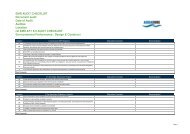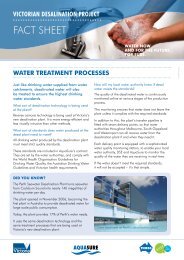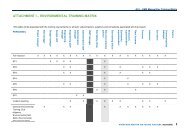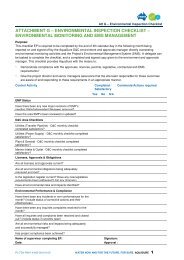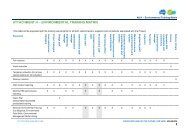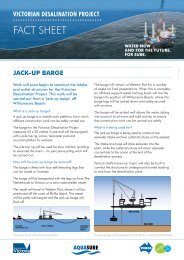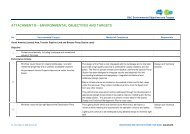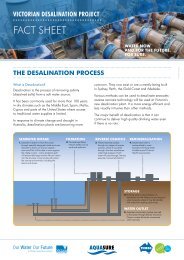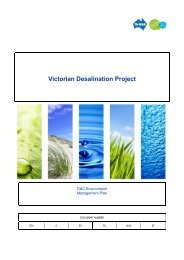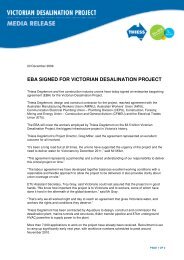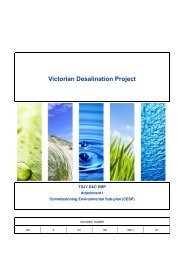Commissioning the Desalination Plant - Aquasure
Commissioning the Desalination Plant - Aquasure
Commissioning the Desalination Plant - Aquasure
Create successful ePaper yourself
Turn your PDF publications into a flip-book with our unique Google optimized e-Paper software.
VICTORIAN DESALINATION PROJECT<br />
FACT SHEET<br />
<strong>Commissioning</strong> <strong>the</strong> desalination plant<br />
TDV-FS-0029-00<br />
With construction of Victoria’s new desalination plant nearing completion, commissioning<br />
is now underway – a complex and essential process that all desalination plants must<br />
go through.<br />
What is commissioning<br />
The commissioning process is designed to confirm that <strong>the</strong><br />
desalination plant can reliably produce high quality drinking water<br />
in commercial quantities, as required under AquaSure’s contract.<br />
At Victoria’s new desalination plant, more than 200,000 tests will<br />
be carried out on 28,500 individual pieces of equipment, before<br />
<strong>the</strong>y can all come toge<strong>the</strong>r as one.<br />
How does commissioning work<br />
The commissioning process involves a number of stages.<br />
1. Precommissioning<br />
Detailed quality assurance checks are carried out to confirm that equipment has been<br />
installed correctly and conforms with specifications. Fu<strong>the</strong>r tests <strong>the</strong>n confirm that<br />
equipment functions correctly as part of <strong>the</strong> plant’s sophisticated operating system.<br />
2. Wet<br />
commissioning<br />
Water is introduced to <strong>the</strong> system, and fur<strong>the</strong>r tests carried out to confirm that<br />
equipment is capable of moving water at <strong>the</strong> required flow and pressure, and that<br />
control systems continue to operate correctly.<br />
3. Process<br />
commissioning<br />
Chemicals are introduced and <strong>the</strong> first samples of test water produced and tested<br />
to confirm that water chemistry is correct and consistent.<br />
4. Performance<br />
testing<br />
A series of performance tests to prove that <strong>the</strong> plant is capable of reliably producing<br />
high quality drinking water in commercial quantities. These tests are a requirement<br />
under AquaSure’s contract and include 7- and 30-day continuous operating tests.
How long does commissioning take<br />
<strong>Commissioning</strong> is a detailed process, which begins<br />
as key elements of construction are completed.<br />
In total, <strong>the</strong> process will take around nine months to<br />
complete.<br />
Issues can and do come up, and identifying and<br />
addressing <strong>the</strong>m well before <strong>the</strong> desalination plant<br />
begins operating is exactly what <strong>the</strong> commissioning<br />
process is for, and can prove as simple as replacing<br />
a part under warranty.<br />
Who will oversee <strong>the</strong> commissioning process<br />
The commissioning process will be overseen by <strong>the</strong><br />
Independent Reviewer and Environmental Auditor for<br />
<strong>the</strong> project.<br />
The Environment Protection Authority (EPA) will<br />
also play an active role, confirming that <strong>the</strong> plant is<br />
meeting all necessary environmental guidelines.<br />
Are <strong>the</strong>re any approvals required prior to starting<br />
commissioning<br />
Yes. The EPA has issued an approval for <strong>the</strong><br />
commissioning activities, under Section 30A of<br />
<strong>the</strong> Environment Protection Act 1970.<br />
The approval outlines <strong>the</strong> conditions under<br />
which commissioning activities must be carried<br />
out. It can be viewed on <strong>the</strong> EPA’s website at<br />
www.epa.vic.gov.au.<br />
How many people are involved in process<br />
commissioning<br />
Unlike <strong>the</strong> construction phase of <strong>the</strong> project, <strong>the</strong><br />
process commissioning team is relatively small,<br />
comprising approximately 40 people.<br />
When will desalinated water be available from<br />
<strong>the</strong> plant<br />
Desalinated water will not enter <strong>the</strong> water network<br />
until <strong>the</strong> final water product is tested to confirm it<br />
meets Australian Drinking Water Guidelines, Victorian<br />
health requirements and <strong>the</strong> water quality standards<br />
specified in <strong>the</strong> contract.<br />
Water will also be tested by an independent water<br />
testing laboratory.<br />
Water will gradually enter <strong>the</strong> network during<br />
commissioning.<br />
DID YOU KNOW<br />
Degrémont has been operating in<br />
Australia for 40 years. Around 20% of<br />
Australia’s population is provided with<br />
drinking water from Degrémont<br />
facilities on a daily basis.<br />
Degrémont has built and operated<br />
more than 260 desalination plants<br />
around <strong>the</strong> world.<br />
Specialist engineers from Degrémont<br />
will lead <strong>the</strong> commissioning process<br />
of Victoria’s new desalination plant.
A LOOK INSIDE THE COMMISSIONING PROCESS<br />
Outlined below are just a few of <strong>the</strong> 200,000 performance and reliability tests that <strong>the</strong> desalination<br />
plant and its supporting infrastructure must pass before it begins commercial operation.<br />
<strong>Commissioning</strong> <strong>the</strong> reverse osmosis membranes<br />
The heart of <strong>the</strong> desalination plant is <strong>the</strong> reverse<br />
osmosis building, where seawater is pushed through<br />
55,000 membranes to separate salt from seawater.<br />
To prepare <strong>the</strong> membranes for operation, <strong>the</strong><br />
many components and pumps that drive <strong>the</strong><br />
membranes will first be tested and checked to<br />
confirm <strong>the</strong>y have been installed correctly.<br />
These tests are carried out both with and<br />
without water, to check that equipment continues<br />
to function as required.<br />
When <strong>the</strong> commissioning team is confident that<br />
all systems and equipment are operating correctly,<br />
seawater is pushed through <strong>the</strong> reverse osmosis<br />
membranes.<br />
Seawater concentrate is checked and analysed,<br />
<strong>the</strong>n returned to <strong>the</strong> ocean, while pure water is<br />
potabilised, tested and analysed against <strong>the</strong><br />
required drinking water standards, <strong>the</strong>n also<br />
returned to <strong>the</strong> ocean.<br />
Put simply, <strong>the</strong> commissioning team is producing<br />
potable water simply to confirm that <strong>the</strong> membranes<br />
and <strong>the</strong>ir operating systems are operating correctly.<br />
<strong>Commissioning</strong> <strong>the</strong> transfer pipeline<br />
Hydrotesting of <strong>the</strong> transfer pipeline is one<br />
of many activities that form part of <strong>the</strong><br />
commissioning process.<br />
To conduct a hydrotest, <strong>the</strong> transfer pipeline<br />
is filled with water and pressurised well above<br />
standard operating limits.<br />
A certified, independent technician <strong>the</strong>n carries<br />
out a series of detailed inspections and quality<br />
tests to confirm that <strong>the</strong> transfer pipeline and its<br />
supporting structures, like air valves, have been<br />
well constructed and are operating correctly.<br />
<strong>Commissioning</strong> <strong>the</strong> power cable<br />
When underground power cable installations<br />
and terminations are complete, all components<br />
such as transformers, circuit breakers and<br />
monitoring equipment are checked.<br />
The process of connecting <strong>the</strong> power to <strong>the</strong> grid<br />
and making it ‘live’ is called energisation.<br />
Energisation is initially carried out at low voltage,<br />
with crews checking that all components are<br />
performing correctly.<br />
When this work is complete, <strong>the</strong> cable is fully<br />
energised to 220kV and power from <strong>the</strong> grid is<br />
<strong>the</strong>n available at <strong>the</strong> plant site.
When will <strong>the</strong> desalination plant start<br />
producing waste<br />
The desalination plant will begin producing waste<br />
during <strong>the</strong> advanced stages of commissioning.<br />
What kinds of waste will <strong>the</strong> desalination<br />
plant produce<br />
The desalination plant will generate two main<br />
waste streams – liquid waste (known as ‘seawater<br />
concentrate’ or ‘brine’) and solid waste (often<br />
referred to as ‘sludge’).<br />
Where will <strong>the</strong> waste be disposed<br />
Brine will be returned to <strong>the</strong> ocean, while solid<br />
waste will be trucked away to landfill.<br />
Only when <strong>the</strong> plant begins producing solid waste,<br />
can it be classified by <strong>the</strong> EPA. This classification<br />
will dictate where <strong>the</strong> waste can be disposed.<br />
Do you need approval to discharge brine to<br />
<strong>the</strong> ocean<br />
Yes. Any form of discharge into public waters requires<br />
approval from <strong>the</strong> EPA, and Victoria’s desalination plant<br />
is no exception. The EPA has issued an approval for<br />
commissioning activities, which specifies discharge<br />
requirements.<br />
Would <strong>the</strong> solid waste ever be disposed to <strong>the</strong> ocean<br />
No. This would be a significant violation of EPA<br />
guidelines and <strong>the</strong> environmental performance<br />
requirements for <strong>the</strong> project, and would put AquaSure’s<br />
license to operate at serious risk.<br />
It is also not physically possible. The solid waste looks<br />
and feels like soft clay, and <strong>the</strong> plant is simply not<br />
equipped with <strong>the</strong> infrastructure required to discharge<br />
such material.<br />
Fur<strong>the</strong>r reading<br />
• Water Treatment Processes Fact Sheet<br />
• Pipeline Hydrotesting Fact Sheet<br />
Printed on Tudor RP, an Australian made paper that contains 100% recycled fibre. No chlorine bleaching occurs in <strong>the</strong> recycling process<br />
and Australian Paper is ISO 14001 certified. Sales of Tudor RP support Landcare Australia.<br />
CONTACT US<br />
Visit <strong>the</strong> Victorian <strong>Desalination</strong> Project Community Information Centre<br />
Shop 2, 33– 35 Murray St, Wonthaggi<br />
Opening hours Wednesday – Friday 9.30am – 4.30pm.<br />
MARCH 2012<br />
Freecall<br />
1800 811 214<br />
Email<br />
contactus@aquasure.com.au<br />
Web<br />
www.aquasure.com.au<br />
www.water.vic.gov.au/desalination<br />
Post<br />
AquaSure C/– PO Box 7387<br />
St Kilda Road, Melbourne<br />
VIC 8004




